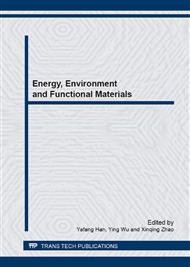p.419
p.425
p.431
p.436
p.442
p.448
p.454
p.460
p.468
Biocompatibility Evaluation of Cellulose Nanowhisker from Bamboo Fibers for Potential Applications of Drug Delivery In Vitro
Abstract:
The biocompatibility of the cellulose nanowhisker (CNW) from cellulase hydrolysis was evaluated in vitro for potential applications in drug delivery system. The assessments were comprised of cytotoxicity analysis and proliferation of human osteosarcoma MG-63 cells that were cultured with the resultant CNW. Some morphological and physico-chemical characteristics of the CNW were investigated. The cellulase hydrolysis conditions were optimized at a cellulase dosage of 0.01 mL/g dried fibers, a hydrolysis temperature of 60 °C, hydrolysis time of 3 h and bamboo fiber concentration of 2 wt%. Under these conditions, the as-prepared CNW retained more properties similar to the original bamboo fibers than those fabricated by sulfuric acid hydrolysis. Indirect cytotoxicity test of the CNW revealed it non-toxicity to the cells. The proliferation of the MG-63 cells with the CNW from cellulase hydrolysis was better than that from sulfuric acid hydrolysis. These results together with the fact that the cellulose hydrolysis preparation of CNW is simple and inexpensive make it a good candidate for the design of oral drug delivery device.
Info:
Periodical:
Pages:
468-473
Citation:
Online since:
April 2014
Authors:
Keywords:
Price:
Сopyright:
© 2014 Trans Tech Publications Ltd. All Rights Reserved
Share:
Citation:


